Power Pitch
Pitch: Hyperpolarized MR
ISMRM & ISMRT Annual Meeting & Exhibition • 03-08 June 2023 • Toronto, ON, Canada

08:15 |
0839.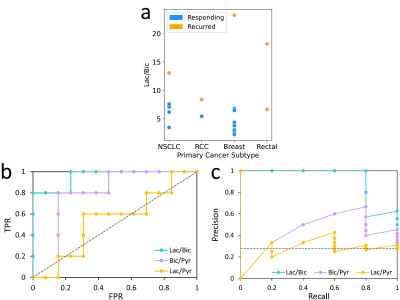 |
Pre-treatment hyperpolarized 13C-lactate to 13C-bicarbonate
ratio predicts response of brain metastases to stereotactic
radiosurgery
Nicole I.C. Cappelletto1,
Hany Soliman2,
Casey Y. Lee1,
Nadia D. Bragagnolo3,
Biranavan Uthayakumar1,
Arjun Sahgal2,
Albert P. Chen4,
Ruby Endre3,
Nathan Ma5,
William J. Perks5,
Jay S. Detsky2,
Chris Heyn6,
and Charles H. Cunningham1,3
1Department of Medical Biophysics, University of Toronto, Toronto, ON, Canada, 2Radiation Oncology, Sunnybrook Health Sciences Centre, Toronto, ON, Canada, 3Physical Sciences, Sunnybrook Research Institute, Toronto, ON, Canada, 4GE Healthcare, Toronto, ON, Canada, 5Pharmacy, Sunnybrook Health Sciences Centre, Toronto, ON, Canada, 6Radiology, Sunnybrook Health Sciences Centre, Toronto, ON, Canada Keywords: Hyperpolarized MR (Non-Gas), Cancer, Treatment Response Prediction, Radiotherapy, Brain Metastases, Metabolism Brain metastases are increasingly being treated with stereotactic radiosurgery; however, 20-30% of treated tumors locally recure post treatment. Hyperpolarized [1-13C]pyruvate magnetic resonance imaging (HP 13C MRI) is an emerging metabolic imaging modality that measures key metabolic phenotypes indicative of aggressive tumor phenotypes. Here we show that the pre-treatment tumor 13C-lactate to 13C-bicarbonate ratio – a marker of glycolysis and (indirectly) oxidative phosphorylation – measured via HP [1-13C]pyruvate MRI is a robust predictor of local recurrence (AUCROC=0.95, p=0.0008; AUCPRC=0.92) and can inform treatment decisions should the model predict a non-response to SRS. |
| 08:15 |
0840.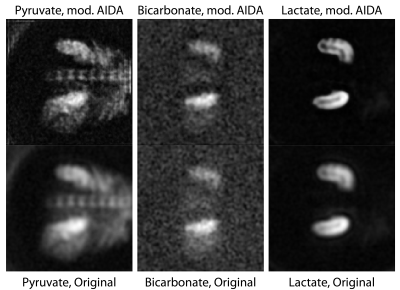 |
Deconvolution for Hyperpolarized Magnetic Resonance Imaging
Jack J. Miller1,2,
Nikolaj Bøgh1,
Andrew Tyler3,
Justin Y C Lau4,
Esben Søvsø Szocska Hansen1,
Michael Væggemose1,5,
Oliver Rider6,
Damian Tyler6,
and Christoffer Laustsen1
1The MR Research Centre, Aarhus University, Aarhus, Denmark, 2OCMR, Radcliffe Department of Medicine, University of Oxford, Oxford, United Kingdom, 3King's College London, London, United Kingdom, 4GE Healthcare, Schenectady, NY, United States, 5GE Healthcare, Brøndby, Denmark, 6OCMR, RDM, University of Oxford, Oxford, United Kingdom Keywords: Hyperpolarized MR (Non-Gas), Data Analysis Hyperpolarized metabolic imaging is translating into clinical practice. However, the desire to obtain chemical, spatial and temporal information combined with the finite and non-renewable exogenous magnetisation provided by hyperpolarized techniques often results in imaging sequences with a poor point-spread function. Here we compare multiple deconvolution algorithms to improve apparent reconstructed resolution, as is commonly performed in PET imaging. We show that deconvolution can significantly improve the reconstructed resolution of hyperpolarized images. |
| 08:15 |
0841.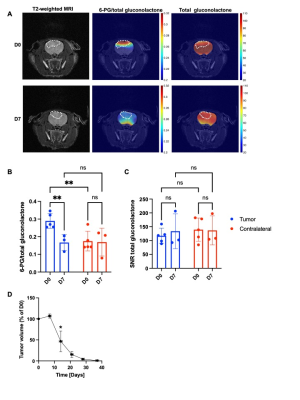 |
Hyperpolarized δ-[1-13C]-gluconolactone reports on TERT
expression and response to therapy in brain tumors
Georgios Batsios1,
Celine Taglang1,
Anne Marie Gillespie1,
and Pavithra Viswanath1
1University of California, San Francisco, San Francisco, CA, United States Keywords: Hyperpolarized MR (Non-Gas), Cancer, animals, preclinical, brain, metabolism TERT expression is essential for telomere maintenance and uncontrolled tumor proliferation in oligodendrogliomas. TERT is an attractive therapeutic target and the drug 6-thio-2’-deoxyguanosine that disrupts telomere maintenance is in clinical trials for cancer. We previously showed that TERT expression is associated with upregulation of the pentose phosphate pathway in oligodendrogliomas. Here, we have established the ability of hyperpolarized δ-[1-13C]-gluconolactone, a probe of the pentose phosphate pathway, to assess TERT expression and response to 6-thio-2’-deoxyguanosine in oligodendrogliomas in vivo. Our findings provide a non-invasive method of imaging a hallmark of cancer and have the potential to improve management of oligodendroglioma patients. |
08:15 |
0842.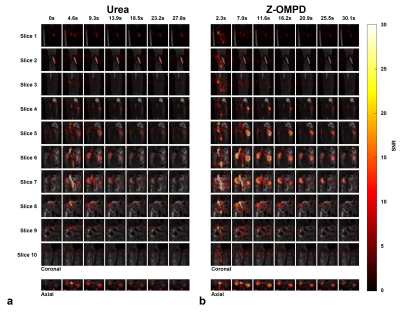 |
Image- and spectroscopy-based quantitative assessment of
renal function using hyperpolarized 13C-labelled Z-OMPD
Martin Grashei1,
Pascal Wodtke1,
Jason G Skinner1,
Sandra Sühnel1,
Nadine Setzer1,
Christian Hundshammer1,
and Franz Schilling1
1TUM School of Medicine, Department of Nuclear Medicine, Technical University of Munich, Munich, Germany Keywords: Hyperpolarized MR (Non-Gas), Non-Proton, Z-OMPD, Urea, Kidney Fast and accurate assessment of kidney function is crucial for monitoring and detection of kidney disease and failure in various oncological scenarios. Current techniques rely on non‑spatially resolved blood or urine biomarkers and possess time- or safety-related constraints when using MRI or CT. Here, we demonstrate fast 3D bSSFP imaging and slice spectroscopy protocols using hyperpolarized [1,5-13C2]Z-OMPD for assessment of renal perfusion and filtration in comparison with 13C-urea as an established perfusion agent. Measured renal blood flow and glomerular filtration rates agree with literature and between agents and methods, thereby rendering Z-OMPD a versatile agent for assessment of kidney functionality. |
08:15 |
0843. |
Development for hyperpolarized [1-13C]alpha-ketoglutarate
MRI for metabolic imaging of normal volunteers and mutant
IDH glioma patients
Yaewon Kim1,
Duy Dang1,
James Slater1,
Andrew Riselli1,
Jeremy Gordon1,
Susan Chang2,
Yan Li1,
Evelyn Escobar1,
Hsin-Yu Chen1,
Chou T Tan3,
Chris Suszczynski3,
Robert Bok1,
and Dan Vigneron1,2
1Department of Radiology and Biomedical Imaging, University of California, San Francisco, CA, United States, 2Department of Neurological Surgery, University of California, San Francisco, CA, United States, 3ISOTEC Stable Isotope Division, MilliporeSigma, Miamisburg, OH, United States Keywords: Hyperpolarized MR (Non-Gas), Non-Proton Hyperpolarized [1-13C]alpha-ketoglutarate (aKG) is a metabolic probe that can provide direct access to the metabolic pathway for glutamate production or 2-HG production in altered alpha-ketoglutarate metabolism via IDH mutations. With its potential to serve as a biomarker of IDH1 mutational status in glioma and a measure of aKG metabolism in normal healthy subjects, we developed a new chemistry preparation and standard operating procedure (SOP) for on-site production of hyperpolarized GMP [1-13C]alpha-ketoglutarate and characterized the probe to investigate the feasibility of this probe in clinical setting. Following process qualification trials with HP [1-13C]aKG, an FDA IND application was prepared and submitted. |
| 08:15 |
0844.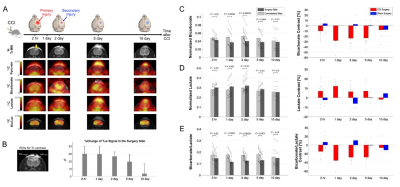 |
PDH flux is a sensitive biomarker of mitochondrial
dysfunction in acute TBI
Jun Chen1,
Edward Hackett1,
Laura Ingle2,
Sarah Al Nemri1,
Erik J Plautz2,
Brenda L Bartnik-Olson3,
and Jae Mo Park4,5
1Advanced Imaging Research Center, UT Southwestern Medical Center at Dallas, Dallas, TX, United States, 2Department of Neurology and Neurotherapeutics, UT Southwestern Medical Center at Dallas, Dallas, TX, United States, 3Radiology, Loma Linda University, Loma Linda, CA, United States, 4Advanced Imaging Research Center,, UT Southwestern Medical Center at Dallas, Dallas, TX, United States, 5Department of Radiology, UT Southwestern Medical Center at Dallas, Dallas, TX, United States Keywords: Hyperpolarized MR (Non-Gas), Brain Due to the rapid and complex progression of metabolic alteration after traumatic brain injury (TBI), prompt assessment of cerebral metabolism is critical in preventing the subsequent injury processes and developing proper therapeutic strategies. In this study, we assessed longitudinal changes in bicarbonate production from hyperpolarized [1-13C]pyruvate in a rat TBI model. In addition to elevated lactate production, we observed significantly reduced bicarbonate production in the injured site. The contrast of bicarbonate signals between the injured region and the contralateral brain peaked at one day post-injury. A subset of TBI rats demonstrated markedly increased bicarbonate in contralateral brain regions post-injury. |
| 08:15 |
0845. |
Novel Structure-guided Design of Amino Acid based
Hyperpolarized 13C Probes for Metabolic Imaging
Kazutoshi Yamamoto1,
Yutaro Saito2,
Hiroyuki Yatabe2,
Norikazu Koyasu1,
Iori Tamura2,
Yohei Kondo2,
Ryo Ishida1,
Tomohiro Seki1,
Akihiro Eguchi2,
Yoichi Takakusagi1,
Nobu Oshima1,
Murali C. Krishna1,
and Shinsuke Sando2
1National Cancer Institute, National Institutes of Health, Bethesda, MD, United States, 2The University of Tokyo, Bunkyo-ku, Japan Keywords: Hyperpolarized MR (Non-Gas), Molecular Imaging Profiling the metabolic phenotypes of tumors by molecular imaging is a promising approach in treatment planning and response monitoring. Here, dissolution Dynamic Nuclear Polarization (dDNP) is an emerging technique to detect site-specific enzymatic activities noninvasively. While drastic dDNP sensitivity enhancements are advantageous for real-time measurements, the limited number of applicable probes with longer T1 relaxation times continues to be a major drawback particularly for in vivo use. In this presentation, we will demonstrate a framework to design novel dDNP probes, detecting APN enzymatic activities which is a cancer therapeutic target, and its applications to in vivo pancreatic cancer. |
| 08:15 |
0846. |
Beyond lactate: using hyperpolarized [1-13C] pyruvate to
measure human brain pH and amino acid metabolism
Alixander S Khan1,2,
Joshua Kaggie1,2,
Ines Horvat-Menih1,2,
Tomasz Matys1,
Rolf F Schulte3,
Matthew Locke1,2,
Ashley Grimmer1,2,
Elizabeth Latimer1,2,
Amy Frary1,2,
Martin Graves1,
Mary McLean1,2,
and Ferdia Gallagher1,2
1Department of Radiology, University of Cambridge, Cambridge, United Kingdom, 2Cancer Research UK Cambridge Institute, Cambridge, United Kingdom, 3GE Healthcare, GE Healthcare, Munich, Germany Keywords: Hyperpolarized MR (Non-Gas), Hyperpolarized MR (Non-Gas) Hyperpolarized 13C MRS was used to measure human brain pH for the first time following 13C imaging through measurements of 13CO2 and bicarbonate. Aspartate concentration was also found offering insight into amino acid metabolism. Global brain pH was measured in the brain to be 6.98 ± 0.06. Non-invasive measurements of cerebral pH could be particularly important in assessing cerebral pathology given the wide range of disease processes that alter acid-base balance. Aspartate was measured in 4 of 9 volunteers with no age-related trends seen. Pyruvate carboxylase flux was found to be 6% of pyruvate dehydrogenase flux. |
| 08:15 |
0847.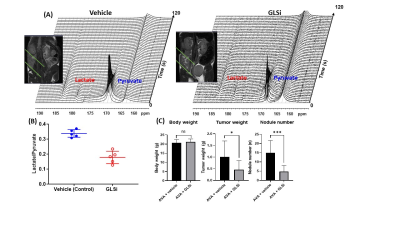 |
Assessing Glutaminase Inhibition Treatment Response in
Ovarian Cancer by Hyperpolarized Magnetic Resonance
Spectroscopy
Prasanta Dutta1,
Deanna Glassman2,
Mark Kim2,
Meredith L Spradlin3,
Emine Bayraktar2,
Elaine Stur2,
Selanere Mangala2,
Katherine Foster2,
Sanghoon Lee2,
Timothy A Yap4,
Shannon Westin2,
Livia Eberlin5,
Anil K Sood2,
and Pratip Bhattacharya1
1Cancer Systems Imaging, UT-MD Anderson Cancer Center, Houston, TX, United States, 2Gynecologic Oncology and Reproductive Medicine, UT-MD Anderson Cancer Center, Houston, TX, United States, 3Chemistry, UT- Austin, Austin, TX, United States, 4Investigational Cancer Therapeutics, UT-MD Anderson Cancer Center, Houston, TX, United States, 5Surgery, Baylor College of Medicine, Houston, TX, United States Keywords: Hyperpolarized MR (Non-Gas), Metabolism, Metabolic Imaging The metabolic vulnerability of anti-VEGF antibody (AVA) resistant ovarian cancer with glutaminase inhibitor (GLSi) therapy was assessed by hyperpolarized 13C-pyruvate magnetic resonance spectroscopy (HP-MRS) in vivo and by desorption electrospray ionization spectroscopic (DESI-MS) imaging ex vivo. The lactate-to-pyruvate ratio was used as the treatment response imaging biomarker. |
| 08:15 |
0848. |
Improving Quantification of Hyperpolarized 13C-Pyruvate
Metabolism Using Pyruvate Metabolite Specific bSSFP and
Variable Flip Angles
Anna Bennett1,
Xioaxi Liu1,
Avantika Sinha1,
Sule Sahin1,
Peder E. Z. Larson1,
and Charlie Wang1
1Department of Radiology and Biomedical Imaging, University of California, San Francisco, San Francisco, CA, United States Keywords: MR Fingerprinting/Synthetic MR, RF Pulse Design & Fields, variable flip angle A pyruvate-specific bSSFP protocol was defined, based on prior work, demonstrating increased signal efficiency over GRE sequences. Monte Carlo simulations evaluated signal efficiency and kinetic performance of potential flip angle schemes. A sigmoid-based flip scheme, varying from 5 to 80 degrees, showed greatest performance of kPL estimation compared to simulated GRE and constant flip angle bSSFP. Small animal studies validated the expected signal increase and kPL estimation, with resulting kinetic parameter maps showing consistency among methods and qualitative noise reduction. |
| 08:15 |
0849.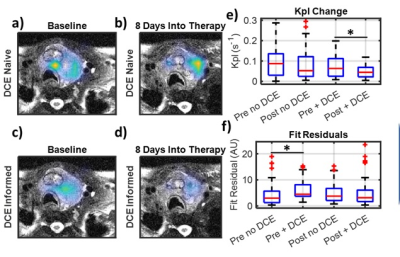 |
Incorporating DCE derived perfusion terms to inform fitting
of hyperpolarized pyruvate metabolism in a human thyroid
tumor.
Christopher M Walker1,
Renjie He2,
Zhan Xu1,
Keith Michel1,
Gary Martinez1,
Collin J. Harlan1,
Abdallah S. R. Mohamed2,
Clifton D. Fuller 2,
Stephen Y. Lai3,
and James A Bankson1
1Imaging Physics, MD Anderson Cancer Center, Houston, TX, United States, 2Department of Radiation Oncology, MD Anderson Cancer Center, Houston, TX, United States, 3Head and Neck Surgery, MD Anderson Cancer Center, Houston, TX, United States Keywords: Hyperpolarized MR (Non-Gas), Hyperpolarized MR (Non-Gas) Dynamic contrast enhanced MRI was used to derive perfusion terms which were incorporated into the fitting of hyperpolarized pyruvate to lactate apparent conversion rates. Incorporation of the DCE data reduced the fit metabolic conversion rates across the data set but more so for the post therapy data resulting in a significant decrease in kpl after therapy. These results suggest that more effort is needed to disentangle perfusion from metabolic effects when analyzing HP MRI data. |
| 08:15 |
0850.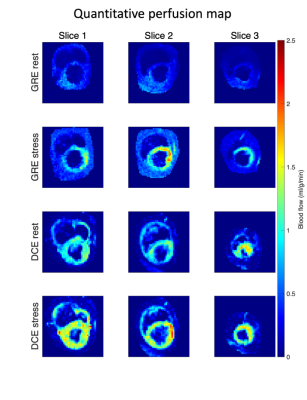 |
3D myocardial perfusion quantification using hyperpolarized
HP001
Yupeng Zhao1,
Rie Beck Olin1,
Lars G. Hanson1,2,
Esben Søvsø Szocska Hansen3,
Christoffer Laustsen3,
and Jan Henrik Ardenkjær-Larsen1
1Technical University of denmark, Kongens Lyngby, Denmark, 2Danish Research Centre for Magnetic Resonance, Hvidovre, Denmark, 3MR Research Centre, Aarhus University, Aarhus, Denmark Keywords: Hyperpolarized MR (Non-Gas), Perfusion We propose a 3D gradient echo sequence with hyperpolarized HP001 as contrast agent for whole heart myocardial perfusion quantification. The estimated perfusion values are correlated with the perfusion values estimated from dynamic contrast enhanced (DCE)-MRI. |
| 08:15 |
0851. |
Multi-Voxel PRESS of Hyperpolarized 13C-labelled Agents In
Vivo
Wolfgang Gottwald1,
Irina Heid2,
Luca Nagel1,
Martin Grashei1,
Sebastian Bauer1,
Mariia Semina2,
Nadine Setzer1,
Sandra Suehnel1,
Geoffrey J. Topping1,
Rickmer Braren2,3,
and Franz Schilling1
1TUM School of Medicine, Department of Nuclear Medicine, Klinikum Rechts der Isar, Technical University of Munich, Munich, Germany, 2TUM School of Medicine, Institute of Diagnostic and Interventional Radiology, Klinikum Rechts der Isar, Technical University of Munich, Munich, Germany, 3German Cancer Consortium (DKTK, partner Site Munich), Munich, Germany Keywords: Hyperpolarized MR (Non-Gas), Hyperpolarized MR (Non-Gas) A newly developed multi-voxel point resolved spectroscopy (MV-PRESS) sequence was evaluated for the study of murine pancreatic ductal adenocarcinoma (PDAC) using hyperpolarized (HP) 13C-labelled molecules. First, the sequence was compared to standard 2D free-induction decay chemical shift imaging (2D FID-CSI) in vivo using HP [1-13C]pyruvate (PA). Then, multiple ROIs in mice with endogenous PDAC were selected based on anatomical 1H imaging. From those voxels, high resolution spectra using the MV-PRESS sequence were acquired to evaluate differences in pyruvate-to-lactate conversion. Finally, the sequence was used to determine the extracellular pH of tumor lesions and kidneys in the same animal model. |
| 08:15 |
0852. |
High-throughput kinetic analysis in a microfluidic multiwell
platform by dissolution dynamic nuclear
polarization-magnetic resonance
Marc Azagra1,
Jose Yeste Lozano1,
Maria Alejandra Ortega 1,
Alejandro Ernesto Portela1,
Gergö Matajsz1,
Alba Herrero Gómez1,
Kim Yaewon2,
Renuka Sriram2,
John Kurhanewicz2,
Daniel Vigneron2,
and Irene Marco Rius1
1MIPMED, IBEC, Barcelona, Spain, 2UCSF, San Francisco, CA, United States Keywords: Hyperpolarized MR (Non-Gas), New Devices, dissolution DNP, MRSI, microfluidics, multisample measurement High throughput dissolution Dynamic Nuclear Polarization (dDNP) magnetic resonance spectroscopic imaging (MRSI) was achieved by developing a multiwell microfluidic platform. This platform allows for multiple experiments to be performed with a single injection of a dDNP substrate, enabling faster and more reproducible data gathering, reducing experimental costs and time by a factor of 8. Here, we present a proof of concept of the methodology with an oxidation reaction combining [1-13C]pyruvic acid with hydrogen peroxide, testing 2 different conditions with 3 replicates each. |
| 08:15 |
0853. |
First in vivo experiences with [1-13C]-pyruvate
hyperpolarized by SABRE
Thomas Theis1,
Austin Browning1,
Keilian MacCulloch1,
Patrick TomHon2,
Carlos Dedesma2,
Boyd M. Goodson3,
Matthew Rosen4,
Eduard Chekmenev5,
David Orestes Guarin-Bedoya4,
and Yi-Fen Yen4
1Chemistry, North Carolina State University, Raleigh, NC, United States, 2Vizma Life Sciences, Raleigh, NC, United States, 3Chemistry, Southern Illinois University, Carbondale, IL, United States, 4A. A. Martinos Center for Biomedical Imaging, Massachusetts General Hospital, Charlestown, MA, United States, 5Chemistry, Wayne State University, Detroit, MI, United States Keywords: Hybrid & Novel Systems Technology, Hyperpolarized MR (Non-Gas) We present the first in vivo hyperpolarized MR using Signal Amplification By Reversible Exchange. |
| 08:15 |
0854. |
Over 20% 13C-Hyperpolarization and Fast Imaging of
Ethyl-[1-13C]-Acetate-d6 and Ethyl-[1-13C]-Pyruvate-d6 using
SAMBADENA
Obaid Mohiuddin1,
Henri de Maissin1,2,
Marvin Herzog1,2,
Andrey Pravdivtsev3,
Arne Brahms4,
Eduard Y. Chekmenev5,6,
Rainer Herges4,
Jan-Bernd Hövener3,
Maxim Zaitsev1,
Dominik von Elverfeldt1,
and Andreas Benjamin Schmidt1,2,5
1Division of Medical Physics, Department of Diagnostic and Interventional Radiology, University Medical Center Frieburg, Freiburg, Germany, 2German Cancer Research Center (DKFZ), Heidelberg, Germany, 3Department of Radiology and Neuroradiology, University Medical Center Schleswig-Holstein and Kiel University, Kiel, Germany, 4Otto Diels Institute for Organic Chemistry, Kiel University, Kiel, Germany, 5Chemistry, Wayne State Univeristy, Detroit, MI, United States, 6Russian Academy of Sciences (RAS), Moscow, Russian Federation Keywords: High-Field MRI, Hyperpolarized MR (Non-Gas), Parahydrogen Parahydrogen is a cost-efficient source of spin order for high-throughput production of hyperpolarized contrast agents. The parahydrogen approach SAMBADENA has shown great potential for biomedical applications: agents are polarized in situ in the MRI system at low cost with little additional hardware, repeatedly every 15s, and administration in vivo has been demonstrated. Here we present a new setup and high 13C polarization of 28% or 19% for ethyl-[1-13C]-acetate-d6 and ethyl-[1-13C]-pyruvate-d6, respectively, at concentrations of up to 80mM. We envision SAMBADENA to become a versatile method for the widespread application of hyperpolarized MRI and high throughput metabolic 13C MRI studies. |
| 08:15 | 0855. | WITHDRAWN |
08:15 |
0856. |
Compressed sense reconstructions improve non-Cartesian
hyperpolarized 129Xe MRI
Joseph W Plummer1,2,
Abdullah S Bdaiwi1,2,
Stephanie A Soderlund1,
Matthew M Willmering1,
Jason C Woods1,3,4,5,
Zackary I Cleveland1,2,4,5,
and Laura L Walkup1,2,4,5
1Center for Pulmonary Imaging Research, Department of Pulmonary Medicine, Cincinnati Children's Hospital Medical Center, Cincinnati, OH, United States, 2Department of Biomedical Engineering, University of Cincinnati, Cincinnati, OH, United States, 3Department of Physics, University of Cincinnati, Cincinnati, OH, United States, 4Department of Radiology, Cincinnati Children's Hospital Medical Center, Cincinnati, OH, United States, 5Department of Pediatrics, Cincinnati Children's Hospital Medical Center, Cincinnati, OH, United States Keywords: Hyperpolarized MR (Gas), Image Reconstruction Hyperpolarized 129Xe MRI is a powerful pulmonary imaging modality to assess regional ventilation, gas exchange, and lung microstructure. However, non-equilibrium magnetization decay and relatively long breath-hold durations remain major limitations to routine clinical dissemination. While non-Cartesian sampling methods can improve sampling efficiency, these methods are yet to be combined with non-linear reconstruction methods like compressed sensing to further increase speed and reduce image noise. Here, we implement compressed-sense reconstructions across a range of non-Cartesian 129Xe MRI techniques and show that SNR and image quality can all be improved while reducing scan time. |
08:15 |
0857. |
Quantifying Cardiogenic Oscillations of Hyperpolarized 129Xe
Gas Exchange MR Spectra in a Healthy Reference Cohort
Anna Costelle1,
Junlan Lu1,
Aryil Bechtel2,
Elianna Bier2,
Sakib Kabir3,
Joseph Mammarrappallil3,
Haoran Dai1,
David Mummy3,
and Bastiaan Driehuys1,2,3
1Medical Physics, Duke University, Durham, NC, United States, 2Biomedical Engineering, Duke University, Durham, NC, United States, 3Radiology, Duke University, Durham, NC, United States Keywords: Hyperpolarized MR (Gas), Spectroscopy Hyperpolarized 129Xe gas exchange MR spectra exhibit cardiogenic oscillations that have been found to distinguish between groups of cardiopulmonary diseases. Specifically, oscillations in the amplitude of the 129Xe red blood cell (RBC) resonance can differentiate pre-capillary and post-capillary pulmonary hypertension. Before diagnostic relevance can be established, these oscillations must be robustly quantified and definitive reference values must be determined. Here, we compare oscillation quantification using a constrained peak-finding algorithm against results from conventional sine fitting. We then employ a well-curated healthy cohort to establish reference values for cardiogenic oscillations in 129Xe RBC spectral parameters, using both methods. |
| 08:15 |
0858. |
Free-Breathing Hyperpolarized Xenon-129 Spectroscopy with
Cardiopulmonary Gating
Faraz Amzajerdian1,
Hooman Hamedani1,
Ryan Baron1,
Mostafa Ismail1,
Luis Loza1,
Kai Ruppert1,
Stephen Kadlecek1,
and Rahim Rizi1
1Radiology, University of Pennsylvania, Philadelphia, PA, United States Keywords: Hyperpolarized MR (Gas), Lung While hyperpolarized 129Xe (HXe) MRI is capable of quantifying gas exchange, these measurements are heavily dependent on both cardiac and pulmonary activity. Since traditional HXe approaches are performed during extended breath-holds at fixed lung inflation levels, the measured gas exchange can differ greatly based on the chosen inflation position, and may thus not be representative of steady-state behavior. To explore the sensitivity of HXe to cardiac pulsations and the different phases of respiration, we acquired spectra continuously over approximately 40 breaths of low-dose HXe before retrospectively gating the signals based on both cardiac and respiratory cycles. |
The International Society for Magnetic Resonance in Medicine is accredited by the Accreditation Council for Continuing Medical Education to provide continuing medical education for physicians.